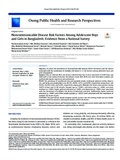Noncommunicable disease risk factors among adolescent boys and girls in Bangladesh: Evidence from a National survey

View/Open
Date
2020-12-11Publisher
Osong public health and research perspectivesAuthor
Urmy, Nushrat JahanHossain, Md. Mokbul
Shamim, Abu Ahmed
Khan, Md. Showkat Ali
Hanif, Abu Abdullah Mohammad
Hasan, Mehedi
Akter, Fahmida
Mitra, Dipak Kumar
Hossaine, Moyazzam
Ullah, Mohammad Aman
Sarker, Samir Kanti
Rahman, SM Mustafizur
Bulbul, Md. Mofijul Islam
Mridha, Malay Kanti
Metadata
Show full item recordCitation
Urmy, N. J., Hossain, M. M., Shamim, A. A., Khan, M., Hanif, A., Hasan, M., Akter, F., Mitra, D. K., Hossaine, M., Ullah, M. A., Sarker, S. K., Rahman, S. M., Bulbul, M., & Mridha, M. K. (2020). Noncommunicable Disease Risk Factors Among Adolescent Boys and Girls in Bangladesh: Evidence From a National Survey. Osong public health and research perspectives, 11(6), 351–364. https://doi.org/10.24171/j.phrp.2020.11.6.03Abstract
Objectives: To assess the prevalence of noncommunicable disease (NCD) risk factors and the factors
associated with the coexistence of multiple risk factors (≥ 2 risk factors) among adolescent boys and
girls in Bangladesh.
Methods: Data on selected NCD risk factors collected from face to face interviews of 4,907 boys and
4,865 girls in the national Nutrition Surveillance round 2018-2019, was used. Descriptive analysis and
multivariable logistic regression were performed.
Results: The prevalence of insufficient fruit and vegetable intake, inadequate physical activity, tobacco
use, and being overweight/obese was 90.72%, 29.03%, 4.57%, and 6.04%, respectively among boys; and
94.32%, 50.33%, 0.43%, and 8.03%, respectively among girls. Multiple risk factors were present among
34.87% of boys and 51.74% of girls. Younger age (p < 0.001), non-slum urban (p < 0.001) and slum
residence (p < 0.001), higher paternal education (p = 0.001), and depression (p < 0.001) were associated
with the coexistence of multiple risk factors in both boys and girls. Additionally, higher maternal
education (p < 0.001) and richest wealth quintile (p = 0.023) were associated with the coexistence of
multiple risk factors in girls.
Conclusion: The government should integrate specific services into the existing health and non-health
programs which are aimed at reducing the burden of NCD risk factors.
